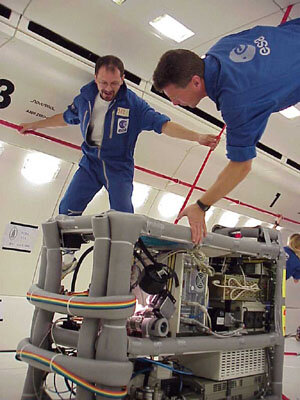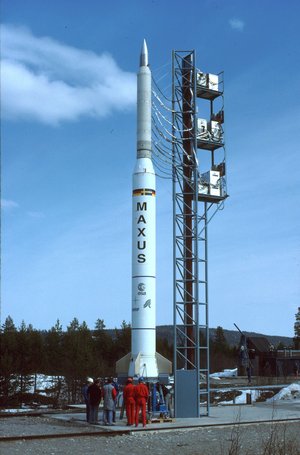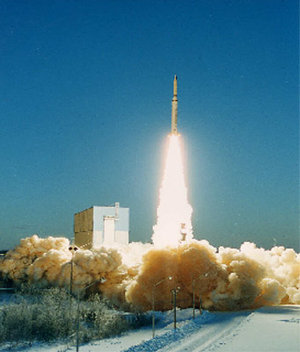Falling upwards: how to create microgravity
Sounding rockets such as Maxus-4 give scientists a relatively inexpensive way to perform experiments in a microgravity environment for a reasonable length of time - usually between five and fifteen minutes. The booster rocket on Maxus-4 will accelerate the rocket to a speed of about 3,600 km/h and an altitude of about 70 km before it burns out. That is less than half the speed required to reach orbit. Even so, it is enough to carry the rocket to a maximum height of 720 kilometres before it falls back to Earth.
From the moment the booster burns out, the rocket and everything inside it are weightless: they are "falling" upwards in exactly the same kind of parabolic path followed by a thrown stone. The stone is only weightless for a few seconds, of course, and air resistance provides a force that nudges it out of a true, free-fall parabola. Maxus-4 will be weightless for 12.5 minutes, and at the 70-kilometre burnout altitude, air resistance is negligible.
Scientists prefer the term microgravity to weightlessness or zero-g because it is more accurate. There is always some residual acceleration force, although in a good microgravity environment it is a very small fraction of the full 1-g gravity that gives us our weight on the surface of the Earth. Incidentally, microgravity does not mean that gravity itself has been reduced, only gravity's effects.
In most cases, the reduction in gravitational effect is temporary. For example: the cheapest and easiest way to experience microgravity is to jump off a cliff. As you fall, you are almost as weightless as an astronaut aboard the International Space Station -- and for exactly the same reason. Like the astronaut, you are falling freely under the acceleration of gravity. The rush of air will add a force that the astronaut does not experience, which means that for scientific purposes you are in a fairly poor microgravity environment: your "weight" is about 1% of what it would be standing on the Earth's surface. (You are also likely to come to serious harm when you hit the ground at the bottom of the cliff.)

For a more prolonged and less fatal encounter with microgravity, you could arrange a trip on the ESA's Airbus 300 Zero-G or on NASA's 'vomit comet'. Essentially, these aircraft fly along flight paths that match the parabolic path of a freely-falling object. For 20-25 seconds at a time, passengers and their experiments are in microgravity of about 0.01 g.
A sounding rocket can do much better, with a maximum duration of a quarter of an hour and microgravity that can be as low as 0.00001 g - one hundred-thousandth of Earth normal. It's also more expensive - but not nearly as expensive as carrying an experiment to the International Space Station. The advantage there is that the microgravity environment will last for many years, but for scientific purposes, it is not as good as a sounding rocket can supply: mainly on account of the bumps and vibrations from life-support systems and people moving about, it is unlikely to be lower than 0.0001 g.
If you want lower microgravity than that, you must arrange to put your experiment aboard an uncrewed research satellite, which will give you about a millionth of a g. But that is about as weightless as you can get anywhere near the Earth: the various gravitational pulls from the Earth, the Moon, the Sun and even the planets will always leave you with a trace of weight.
The best microgravity environment that space scientists have ever created is on board the old Pioneer craft, which stunned the world with their pictures of Jupiter and Saturn in the 1970s. Now, they are the most distant of all manmade objects. As they fall outward from the far fringes of the solar system into interstellar space, they experience only about a ten-millionth of a g.







